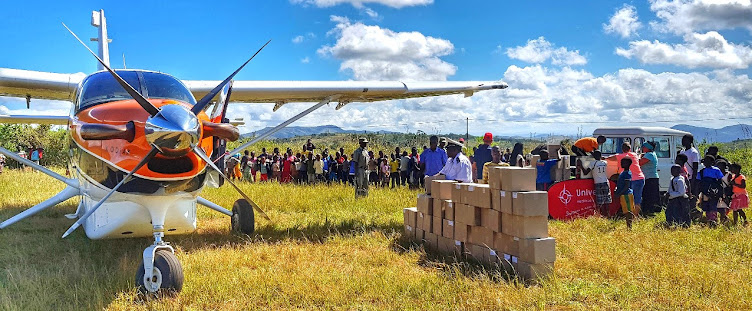So, after a weeks worth of blog posts that basically gave a distance, a time and a handy map, we can finally include some pictures of the Kodiak on home soil.
 |
| At KMIA (Kruger Mpumalanga International Airport) to clear customs and immigration. This is only 8nm from Mercy Air and where we usually start our flights into Mozambique. |
 |
| Quick photo before landing. |
 |
| Final for 06 at the Mercy Air Farm. |
 |
| Landing |
  |
| Taxiing |
 |
| On the apron outside the office. |
 |
| Giving thanks for a safe journey. |
From John:
No doubt, news of the Kodiak's arrival at Mercy Air is old news by now, but
perhaps some news on the last segments of the flight and some of the
highlights and events will be interesting for all those who have followed the
progress keenly. I last wrote while on the longest leg from Las Palmas to
Accra with a very fatigued mind and body. The lower part of the bulge of
Africa and down through Angola, depending on the season, is an area of very
large and dangerous thunderstorms every day, but we caught the day early
before any really serious weather had time to develop. The result of course
was an uneventful arrival in Accra, with a rather amusing but tedious journey
to the hotel where I slept like a baby for 9 hours.
An interesting note about the tedious, but amusing (at the expense of my
phone bill), journey to the hotel from the airport was the result of a serious bit
of haggling with a supposed 'handler' who said they would transport us to the
hotel where Paul had deployed himself the night before. The amusement
was the result of the locals, unable to find the hotel, and their method of
obtaining directions over the phone (mine) while driving, which resulted in a
bumper bashing with another vehicle. Neil and I were ready to abandon the
ride and find another taxi, when after what felt like 3 hours (1 hour actually)
we arrived and were able to shower.
Neil said farewell to me in Accra, and Paul Middleton joined me for the
remainder of the journet. Neil was looking rather jaded as we dropped him off for his flight back to
Johannesburg. The weather for the next 2 days was important and again we
had no diversions for weather enroute to Libreville which was a short hop of
about 4.5 hrs (sounds strange because a 4.5 hr flight prior to this would be
considered a long flight), and for those who are interested, included an IFR
arrival and ILS to about 1000'.
Andrew, my son, is regularly based in Libreville for his job and we used his
company contacts for accommodation and help with formalities at the airport.
This was refreshing change from the impersonal trips to and from hotels and
airports. I was beginning to think Libreville is a good stopover until I was
presented with the bill for navigation, landing and parking fees, a small
fortune (no bribes) for which I was presented with an official receipt. Despite
the fact that I knew it would not make the slightest bit of difference, I
expressed my displeasure in no uncertain terms, paid the cash and walked off a
very grumpy individual only to be told that they had no copy of my clearance,
the end result being that the official was simply too lazy to look through her
file properly. This, and an unfriendly discussion with the 'handler' in Accra
were the only sour notes for the entire trip.
The journey south through Angola was good except for minor diversions due
to some thunderstorm activity, made a little more interesting with the weather
radar suffering from vertigo. Some minor diversions and we ended up in
friendly Namibia and virtually on home ground again. Paul and I enjoyed a
comfortable night and good weather all the way home the next day.
The welcome at Mercy Air in White River was a little overwhelming as there
was a small crowd to welcome us. We did a small air to air photo sortie in the
area before landing. We taxied the aircraft up the ramp between the hangars
and as we came to a stop I suddenly had to choke back some emotion, as
the realisation hit me that not only was the journey over, but that I had, with
God's and other's help, prepared for, managed and executed the exercise
successfully and on schedule.
My reflection now after the attempt earlier this year is that God is sovereign,
as we submit to His plan, He works things out the best way. The attempt in February
to bring the Kodiak to South Africa, was not failure, but
simply another step in preparing us and our hearts for
His service. The aircraft, as a tool, has taken centre stage for
a few weeks now, but we wish to consecrate the aircraft to His
service and ourselves to serve Him with it.
John
 |
| Just when you thought you'd seen the last map - here's one of the total route as recorded by Spidertracks. | 7800 miles, 7 days and almost 50 hours of flying. |
|
|
Thank you
Mercy Air team.




















































